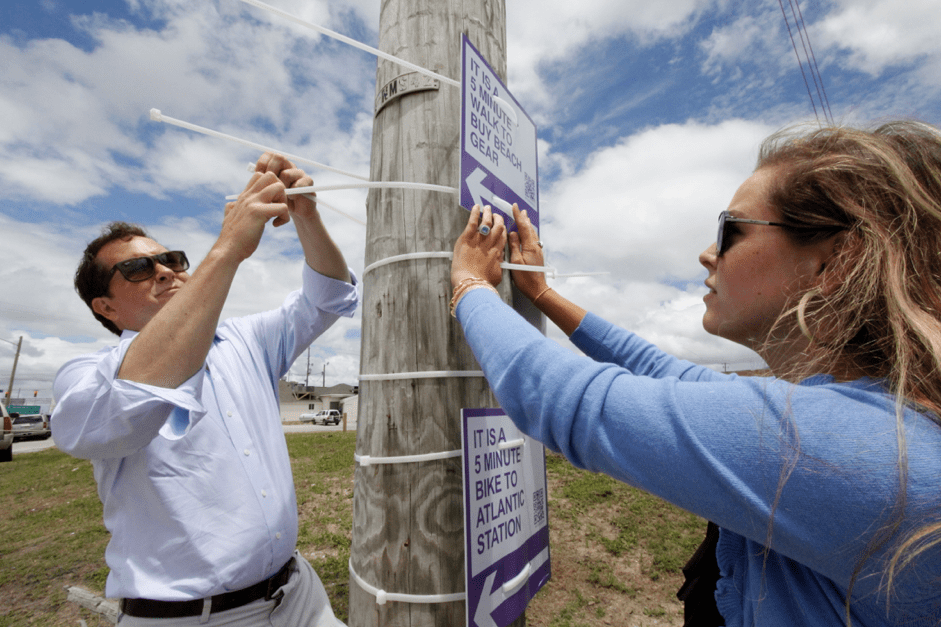
Teaching residents to walk this way…
Photo courtesy of Walk [Your City].
Urban designer Matt Tomasulo is the chief instigator and founder of Walk [Your City], which Knight Foundation supports as part of its efforts to invest in innovators who help cities attract and keep talented people, expand economic opportunity and create a culture of engagement.
One rainy night in 2012, I hung 27 guerrilla walking signs in downtown Raleigh, N.C., as an experiment: What happens when we show residents how many minutes away on foot neighborhood destinations are in their communities? Three years later, the Walk [Your City] team and I are working to empower pedestrians nationwide with the creation of a “do-it-yourself” walkability toolkit, supported by Knight Foundation. RELATED LINKS
“New walkability toolkit to help cities engage young talent in shaping their communities with $182,000 from Knight Foundation” – press release, 02/26/15
How did we get from there to here?
While in grad school back in 2012, I was studying the barriers to people walking as part of their daily lives. Studies show that the perception of destinations being too far to walk – rather than the reality of distance – was the main barrier. While living in larger cities such as D.C. and Copenhagen, I had noticed that people walked 12 to 18 minutes, multiple times a day, without even thinking about it. Could we influence that perception in other communities in the U.S. that do not have the density of D.C., New York and San Francisco?
After backing up my research in school with some simple polls of neighbors – and realizing that many folks thought community amenities were much farther away than they actually were! – “WalkRaleigh” was born. I created simple signs showing distance in a human-scaled metric: minutes, as opposed to miles. The signs were installed at intersections where people make choices on foot, or are stopped in their vehicles.
After outlets from CityLab to BBC News featured the project, the city of Raleigh noticed the signs—which were illegal—and helped us take them down. However, residents and the City Council rallied around the signs with support from the planning office—and they were reinstalled as a pilot educational campaign only weeks later. Interest poured in; more than 100 communities used our Kickstarted open-source sign template to create their own Walk [Your City] campaigns, and we realized we needed an even lighter, cheaper approach. That’s when we turned to software to support our process.
Working directly with communities over the past two years, we’ve found that technology can significantly increase our effectiveness in distributing (and evolving) this idea. Our platform allows communities to develop signage in weeks, for thousands of dollars, rather than in years, for millions. These signs support simple behavior change that can make a big impact: on public health, road safety and congestion, social connection, local business, and civic engagement.
It’s in that last element in particular that we see huge opportunities. We’ve started tying Walk [Your City] into participatory planning projects to “daylight” citizen ideas and engagement around planning for people. Our process is easily integrated with existing corridor studies, small area plans, neighborhood development, etc. – and can turn two hours of direct citizen input into a 60-sign walkability campaign for their community a week later. In addition, we can build further opportunities for engagement with QR codes on the signs.
Working with Knight Foundation in two of its communities—Lexington, Ky., and San Jose, Calif.—will allow us to scale our experimentation, so we can better understand what is needed to convert our platform into a truly DIY walkability toolkit. We want any community to be able to pick up Walk [Your City] and use it independently – ideally to increase engagement of citizens who otherwise might not get involved in the participatory process. The capacity to create rapid, visible change reinforces that residents’ input can have direct impact in their own neighborhoods.
Recent Content
-
Communitiesarticle ·
-
Communitiesarticle ·
-
Communitiesarticle ·


